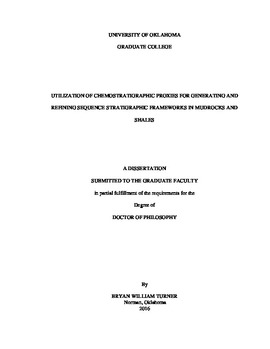| dc.description.abstract | Recent advances in handheld XRF (HHXRF) technology provide an opportunity to demonstrate the utility of chemostratigraphy within mudrock successions. Three cores from Lincoln, Pottawatomie, and Pontotoc Counties in Oklahoma and two outcrops at the Hunton Anticline Quarry (HAQ) in Murray County, OK represent both proximal and distal environments of the Woodford Shale. Clean samples at each area are scanned at no greater than one foot intervals using HHXRF to measure the elemental composition. The elemental profiles are then used to develop the sequence stratigraphic interpretation.
Certain elements act as proxies for depositional and environmental conditions during sedimentation. Ti and Zr are associated with continentally derived sediment. Ca and Sr are associated with carbonate accumulation. Al and K are associated with feldspars and clays. Mo and V can be used as an indication of redox conditions. Si is found in biogenic quartz, detrital quartz, feldspars, and clays. As such, it is useful to evaluate Si as a ratio between Si/Al. These chemostratigraphic successions are capable of resolving high frequency cyclicity that can refine a sequence stratigraphic framework.
Additionally, the ratio between Mo and Total Organic Carbon (Mo-TOC), Ni, Cu, and an approximation for the Degree of Pyritization (aDOP), based on an idealized formula for pyrite (FeS2) can be used to evaluate changing degrees of circulation within a basin.
Within this basin, the chemostratigraphic profile of the Woodford Shale can be interpreted within a sequence stratigraphic framework using the following general criteria. The Lowstand Systems Tract (LST) is defined by increasing concentrations of Ti, Zr, Al, and K as well as high levels of Mo and V. The Transgressive Systems Tract (TST) is defined by upward declining concentrations of Ti and Zr, though Al and K may remain elevated; Mo and V also show a general decline. The Highstand Systems Tract (HST) is defined by increasing concentrations of Ti, Zr, Al, and K, but is distinguished from the LST by low levels of Mo and V.
The lowermost of the Woodford Shale preserves geochemical signals of Mo-TOC, Ni, Cu, Mo, and aDOP that are consistent with a restricted basin that periodically receives influxes of oxygenated water. This is consistent with the onset of rising sea levels flowing into restricted basins and subsequently becoming isolated by localized conditions. The middle portion of the Woodford preserves a signal that indicates an increased degree of circulation. This level of circulation persists until just below the interpreted position of the maximum flooding surface. The uppermost Woodford Shale preserves signals that correspond to high degrees of circulation. Additionally, in this basin, proximal regions show greater restriction and distal regions show greater circulation with the Paleotethys. The presence of paleotopographic highs is hypothesized to control this variation in circulation.
The ability to interpret the changing levels of bottom water anoxia will enable a greater degree of precision in targeting potential resources in hydrocarbon exploration. Furthermore, this information can be used to help improve our understanding of the changing environmental conditions of the Woodford Shale. | en_US |
